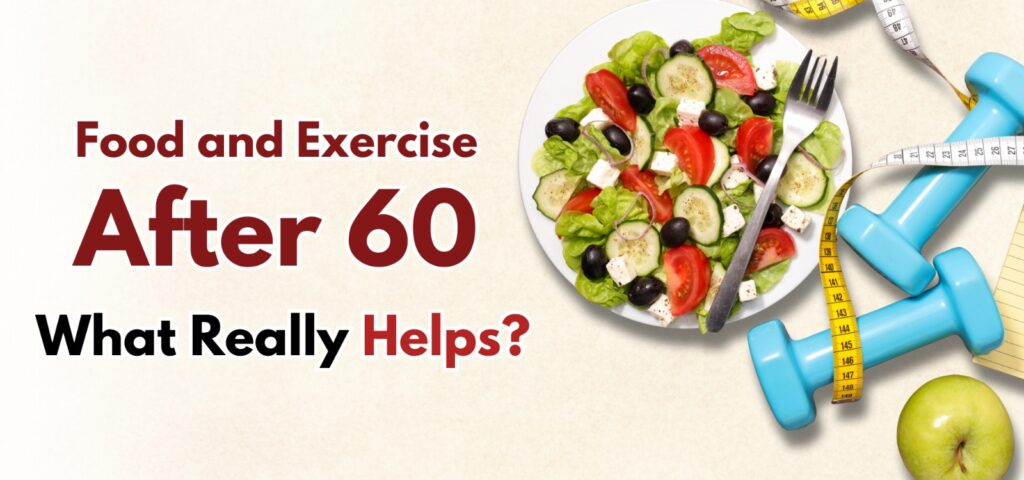Aging gracefully is a dream many people hold, but turning 60 often brings unique challenges. The body doesn’t recover as quickly, metabolism slows down, and staying healthy requires conscious choices. That’s why understanding food and exercise after 60 becomes essential—not just for longevity, but for maintaining energy, independence, and a joyful lifestyle.
At this stage of life, many individuals face issues such as weakened muscles, joint stiffness, digestive changes, and increased risk of chronic conditions like diabetes, heart disease, or osteoporosis. Food and exercise are two powerful tools that can transform the aging experience. Eating the right nutrients and staying physically active after 60 can not only delay aging-related concerns but also improve mental health, mobility, and overall well-being.
In this article, we’ll explore what really helps people over 60 stay strong, active, and healthy. Drawing insights from expert recommendations and valuable references like Dr. Prasun’s book on lifestyle medicine, you’ll find practical strategies to adopt into your daily routine.
What Really Helps? : Let’s Break it Down
1. Understanding the Importance of Food After 60
a) Nutritional Needs Change with Age
The body’s metabolism slows after 60, and so does the ability to absorb certain nutrients. This means older adults require fewer calories but more nutrient-dense foods. Essential nutrients include:
- Protein for muscle strength
- Calcium and Vitamin D for bone health
- Omega-3 fatty acids for heart and brain function
- Fiber for digestion
b) Foods to Prioritize
- Whole grains: Help regulate blood sugar and provide sustained energy.
- Fruits and vegetables: Packed with antioxidants to fight inflammation.
- Lean proteins: Fish, poultry, legumes, and dairy strengthen muscles.
- Healthy fats: Nuts, seeds, and olive oil improve heart health.
c) Foods to Limit
- Processed foods high in salt and sugar.
- Excessive red meat, which may worsen cholesterol levels.
- Sugary drinks that spike blood glucose and add empty calories.
Dr. Prasun highlights in his book that small changes in diet—like adding more leafy greens or replacing refined carbs with whole grains—can dramatically reduce risks of lifestyle diseases in people over 60.
2. Exercise After 60: What Works Best
a) Why Exercise Matters Most Now
Physical activity after 60 doesn’t just burn calories—it preserves independence. Regular movement maintains flexibility, balance, and coordination, reducing fall risks. It also strengthens the heart, supports weight control, and boosts mental health.
b) Types of Exercises Suitable After 60
- Aerobic exercises
- Walking, cycling, or swimming improve cardiovascular health.
- Strength training
- Light weights, resistance bands, or bodyweight exercises prevent muscle loss.
- Flexibility exercises
- Yoga and stretching keep joints mobile and reduce stiffness.
- Balance exercises
- Tai Chi or standing balance drills help prevent falls.
c) Tips for Safe Exercise
- Start slow and increase intensity gradually.
- Consult a doctor before starting any new routine.
- Stay consistent rather than aiming for intensity.
Dr. Prasun emphasizes in his book that “movement is medicine.” Even a daily 30-minute walk can be life-changing after 60.
3. Combining Food and Exercise for Maximum Benefit
a) Timing Matters
- Eating a balanced meal with protein and complex carbs before exercise provides energy.
- A light protein-rich snack afterward aids recovery.
b) Hydration
Older adults often lose the sensation of thirst. Drinking enough water, herbal teas, or soups is essential for energy and joint lubrication.
c) Lifestyle Habits to Support Food and Exercise
- Maintain a consistent sleep cycle.
- Avoid smoking and excess alcohol.
- Stay socially connected to keep motivation high.
4. Common Mistakes People Over 60 Make
a) Overeating Supplements
Relying too much on multivitamins or protein powders instead of natural foods.
b) Ignoring Recovery
Skipping rest days or pushing too hard during exercise.
c) Eating Too Little
Some adults eat too few calories, leading to nutrient deficiencies and weakness.
5. Insights from Dr. Prasun’s Book
Dr. Prasun, in his book on holistic health and lifestyle medicine, stresses that aging does not mean giving up on strength or vitality. Instead, it’s about making smarter choices. He notes:
- A plant-rich diet reduces inflammation.
- Moderate, consistent exercise lowers stress hormones.
- Mindful eating prevents overeating and supports digestion.
His framework supports the philosophy that food and exercise together can be more powerful than medicine in promoting healthy aging.
Conclusion
Food and exercise after 60 are not just about adding years to life, but about adding life to years. Balanced nutrition keeps the body nourished, while regular exercise keeps it strong and functional. By combining these habits with guidance from experts like Dr. Prasun, anyone over 60 can enjoy better mobility, stronger immunity, and a happier, healthier lifestyle.
Instead of fearing aging, embracing mindful eating and consistent activity can make these years the most rewarding. Small, sustainable steps—like walking daily, eating more whole foods, and practicing flexibility exercises—are what really help.

